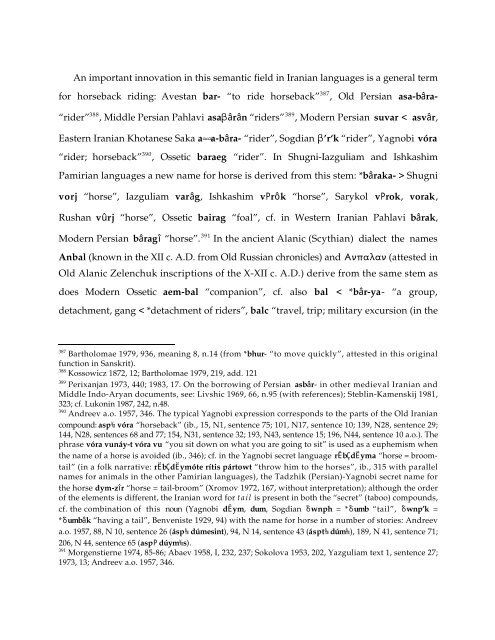Comparative Notes on Hurro-Urartian, Northern Caucasian
Comparative Notes on Hurro-Urartian, Northern Caucasian
Comparative Notes on Hurro-Urartian, Northern Caucasian
You also want an ePaper? Increase the reach of your titles
YUMPU automatically turns print PDFs into web optimized ePapers that Google loves.
An important innovati<strong>on</strong> in this semantic field in Iranian languages is a general term<br />
for horseback riding: Avestan bar- “to ride horseback” 387 , Old Persian asa-bâra-<br />
“rider” 388 , Middle Persian Pahlavi asabârân “riders” 389 , Modern Persian suvar < asvâr,<br />
Eastern Iranian Khotanese Saka a≈≈a-bâra- “rider”, Sogdian b’r‘k “rider”, Yagnobi vóra<br />
“rider; horseback” 390 , Ossetic baraeg “rider”. In Shugni-Iazguliam and Ishkashim<br />
Pamirian languages a new name for horse is derived from this stem: *bâraka- > Shugni<br />
vorj “horse”, Iazguliam varâg, Ishkashim vPrôk “horse”, Sarykol vProk, vorak,<br />
Rushan vûrj “horse”, Ossetic bairag “foal”, cf. in Western Iranian Pahlavi bârak,<br />
Modern Persian bâragî “horse”. 391 In the ancient Alanic (Scythian) dialect the names<br />
Anbal (known in the XII c. A.D. from Old Russian chr<strong>on</strong>icles) and Anpalan (attested in<br />
Old Alanic Zelenchuk inscripti<strong>on</strong>s of the X-XII c. A.D.) derive from the same stem as<br />
does Modern Ossetic aem-bal “compani<strong>on</strong>”, cf. also bal < *bâr-ya- “a group,<br />
detachment, gang < *detachment of riders”, balc “travel, trip; military excursi<strong>on</strong> (in the<br />
387 Bartholomae 1979, 936, meaning 8, n.14 (from *bhur- “to move quickly”, attested in this original<br />
functi<strong>on</strong> in Sanskrit).<br />
388 Kossowicz 1872, 12; Bartholomae 1979, 219, add. 121<br />
389 Perixanjan 1973, 440; 1983, 17. On the borrowing of Persian asbâr- in other medieval Iranian and<br />
Middle Indo-Aryan documents, see: Livshic 1969, 66, n.95 (with references); Steblin-Kamenskij 1981,<br />
323; cf. Luk<strong>on</strong>in 1987, 242, n.48.<br />
390 Andreev a.o. 1957, 346. The typical Yagnobi expressi<strong>on</strong> corresp<strong>on</strong>ds to the parts of the Old Iranian<br />
compound: asp‰ vóra “horseback” (ib., 15, N1, sentence 75; 101, N17, sentence 10; 139, N28, sentence 29;<br />
144, N28, sentences 68 and 77; 154, N31, sentence 32; 193, N43, sentence 15; 196, N44, sentence 10 a.o.). The<br />
phrase vóra vunáy-t vóra vu “you sit down <strong>on</strong> what you are going to sit” is used as a euphemism when<br />
the name of a horse is avoided (ib., 346); cf. in the Yagnobi secret language rËbÇdËyma “horse = broomtail”<br />
(in a folk narrative: rËbÇdËymóte rítis pártowt “throw him to the horses”, ib., 315 with parallel<br />
names for animals in the other Pamirian languages), the Tadzhik (Persian)-Yagnobi secret name for<br />
the horse dym-zîr “horse = tail-broom” (Xromov 1972, 167, without interpretati<strong>on</strong>); although the order<br />
of the elements is different, the Iranian word for tail is present in both the “secret” (taboo) compounds,<br />
cf. the combinati<strong>on</strong> of this noun (Yagnobi dËym, dum, Sogdian dwnph = *dumb “tail”, dwnp’k =<br />
*dumbâk “having a tail”, Benveniste 1929, 94) with the name for horse in a number of stories: Andreev<br />
a.o. 1957, 88, N 10, sentence 26 (ásp‰ dúmesint), 94, N 14, sentence 43 (áspt‰ dúm‰), 189, N 41, sentence 71;<br />
206, N 44, sentence 65 (aspP dúym‰s).<br />
391 Morgenstierne 1974, 85-86; Abaev 1958, I, 232, 237; Sokolova 1953, 202, Yazguliam text 1, sentence 27;<br />
1973, 13; Andreev a.o. 1957, 346.





